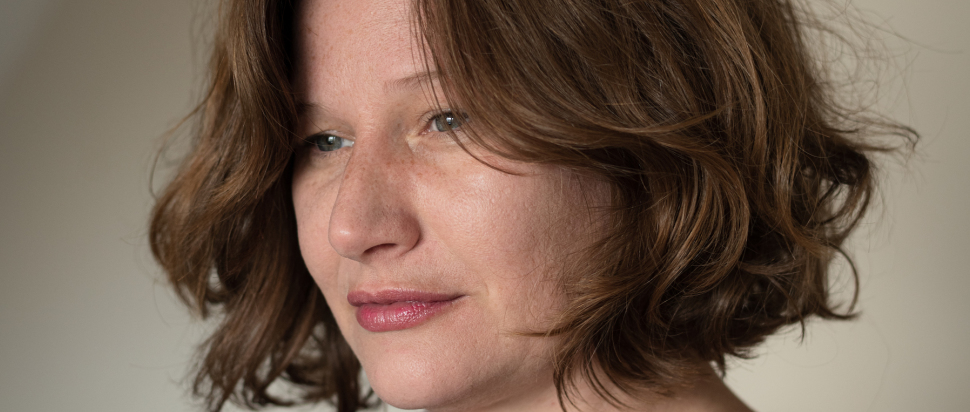Eleanor Thom on new novel Connective Tissue
We chat with Eleanor Thom, author of Connective Tissue, about tracing back her Jewish heritage, intergenerational memory, and the ability of literature to uncover untold stories
At the time of her death in 1980, Eleanor Thom’s grandmother Dora left behind an incomplete embroidered tablecloth and, with it, a story half-told. Arriving in the UK as a refugee in 1939 and eventually settling in Elgin – “a Jew in a family of Travellers” – Dora was unlike other Jewish refugees of her time. She was stateless and from a working-class background, and had been forced to twice leave behind her daughter to survive.
Eleanor Thom’s Connective Tissue delves into the links between grandmother and granddaughter across centuries and borders. What started as PhD research evolved into Thom’s novel, which parallels the experiences of Berlin-based single mother Dora in 1937 and the fictional soon-to-be mother and air-traffic controller Helena in 2010 Scotland. It is a book about universal ties of motherhood that ripple across family lines: as Helena wrestles with her own body and the uncertainty of her son Ash’s medical diagnosis, she reaches back into her family history for answers and comfort. Helena’s tale traces Thom’s own journey to reconnect with her Jewish roots, eventually returning to Berlin years after Dora’s exile. Meanwhile, in Nazi-occupied Berlin, Dora faces an increasingly hostile city and the instability of single motherhood.
Motherhood thus becomes “a tool that you can use to link the centuries,” Thom explains. “There are so many parallels in terms of Dora’s story and stories that are still happening. When you have a conflict, there are people who will find it much harder to flee and who will not have their stories recorded. That is what makes this relevant for today.
“Those testimonies aren’t there,” continues Thom. This slice of history “hasn’t really been made palpable, and even in research, there’s just very little there.”
In writing her grandmother’s story, Thom says she wanted to “make those lives just a little bit more real for people,” bringing into perspective the humanity occasionally lost in the magnitude of the Holocaust and in doing so, highlighting the experience of working-class Jewish people. “Around 40% of Berlin’s Jewish population were living below the poverty line even before the Holocaust,” says Thom. “Very few of them survived because it was harder for them to find a way out and (as a result) even fewer of their testimonies live on.”
For Thom, her novel is an act of “embroidery”; like Dora’s tablecloth, it is half-filled with fact and fiction. Writing in the third person allowed such distance, explains Thom. “It allowed me to do things with Helena that I wouldn’t have been able to do if I had approached it as a complete non-fiction. It was important for me to have a thread that held things together. It is an interpretation, not testimony.”
Within the novel, Thom references a Jewish fairy-tale The Blue Coat, where a grandmother lovingly weaves and unravels a ball of blue yarn to make clothes for her growing grandson. When at last the thread wears thin and breaks, to cheer her grandson up, the grandmother asks him to recount the clothes she has made. Once done, the grandmother says: “The blue wool is now a story, and it will last as long as there is someone to tell it.” And so too does Thom weave together the story of her grandmother’s history with the present and in doing so, turns her own grandmother’s story into one that will outlast its stitches.
During her lifetime, Dora’s family knew little about her past; bits of information “dripped through” recalls Thom. “She had closed that part of her life down and didn’t really speak about it.” We speak about how memory is at times an act of resistance. Assigning life and colour to forgotten corners of the past brings back those whom history has tried to erase, a common theme in the history of most Jewish families.
Names that had been forgotten in the family for decades were uncovered by Thom during her research. She was able to add to Yad Vashem’s database of names lost during the Holocaust, discovering in the process the daughter of her grandmother’s cousin – adopted into Canada and unbeknownst to Dora, who died unaware of her existence. Now, in the aftermath of the book, Thom and her family are reacquainting themselves with their Jewish heritage, attending weekly services at their local synagogue.
After challenging the sexist clause of Article 116 which denied reparational citizenship to descendants exiled between 1933-45 claiming via a female line, Eleanor and her family finally received their German passports this year. “It validated that feeling of a dual identity,” Thom says. “I’ve never felt entirely anything, and this second identity fits.”
Connective Tissue is out with Taproot Press on 6 Sep; Eleanor Thom discusses the book at Golden Hare Books, Edinburgh, 14 Sep, 6.30pm
